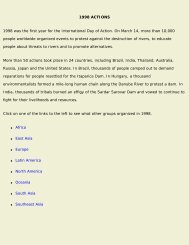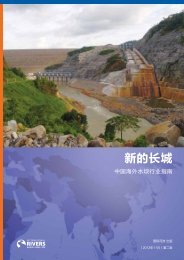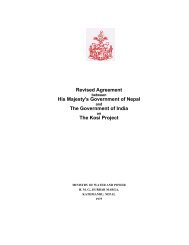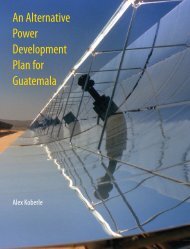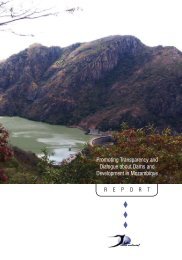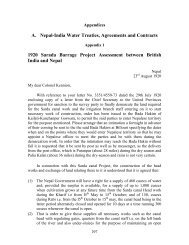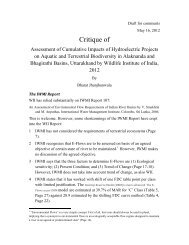Proposed Power Development Plan (PDP) 2012 - Palang Thai
Proposed Power Development Plan (PDP) 2012 - Palang Thai
Proposed Power Development Plan (PDP) 2012 - Palang Thai
- No tags were found...
You also want an ePaper? Increase the reach of your titles
YUMPU automatically turns print PDFs into web optimized ePapers that Google loves.
<strong>Proposed</strong> <strong>Power</strong> <strong>Development</strong> <strong>Plan</strong> (<strong>PDP</strong>) <strong>2012</strong>and a Framework for Improving Accountability and Performance of <strong>Power</strong> Sector <strong>Plan</strong>ning• Promotion of renewable energy• Efficient use of energy• Diversifying fuel risks• Reducing CO 2 emissions• Minimizing impacts from energy procurement• Fair and reasonable costs of energy service to consumersThis paper has proposed one such framework with benchmarks for these objectives including the ratio ofimported to domestic resources, emissions of airborne pollutants and greenhouse gases, and expectedelectricity bills to consumers for energy services delivered.2. Implement a bottom-up load forecast methodology in place of the current econometric load forecastingmethodology. The current methodology, as discussed in this study, has proven to be inadequate, repeatedlypredicting large increases in load that have failed to materialize – and ultimately leading to excessiveinvestment in generation assets. A bottom-up forecast methodology would track trends in electricityconsumption by customer-type, according to each end-use, taking into consideration technological changechanging demographics and economic structure.3. Reform the power development planning methodology and process towards Integrated Resource <strong>Plan</strong>ning(IRP):• Increase participation and public access in the planning process from defining planning objectives todevelopment and review of draft plans. With increased participation during the last two <strong>PDP</strong>s (<strong>PDP</strong> 2007and <strong>PDP</strong> 2010), there were noticeable improvements in the outcome, notably the increased role ofrenewable energy and demand-side management in the <strong>PDP</strong>. Participation can be further increased andwill likely result in a power sector plan that better serves the public interests and is perceived as morelegitimate.• <strong>Power</strong> sector planning should adopt a true least-cost planning process in which the least societal costoption is chosen. This would seem obvious. Costs used in planning analysis should be “cost of deliveredelectricity to end users” not just generation cost for fair comparison. Restricting consideration to onlygeneration cost fails to incorporate transmission and distribution system costs – which make up about40% of <strong>Thai</strong>land’s electricity costs. Energy efficiency and distributed generation reduce end-use electricityrequirement, reducing the need for expensive transmission or distribution system upgrades. Moreover,current cost methodologies also ignore environmental externality costs such as crop losses due to acidrain, health impacts from particulates and mercury emissions, and the cost of global greenhouse gasses.These environmental externality costs should be incorporated in decision-making processes.• Multiple scenarios should be considered in the <strong>PDP</strong> reflecting reasonable assumptions regardinguncertainties in key future variables. The current <strong>PDP</strong> practice creates a single “business as usual” <strong>PDP</strong>with two additional scenarios: “high” and “low” economic growth. In practice, electricity demand hastended to grow significantly below the “baseline” case, or even occasionally below the “low” base. In thePacific Northwest of the USA, the power plan considers 750 scenarios that address combinations ofvariations in economic growth rates, fuel prices, rainfall and snowpack (for hydropower), and variouscarbon pricing scenarios – and then works in a public process to pick plans that are low cost and low riskacross a wide range of possible futures. 16• Resource options considered in the <strong>PDP</strong> should widen from their existing narrow band of options (largecoal, large gas, hydropower imports and nuclear) to include investments in EE/DSM, RE, cogeneration,plant life extension, repowering, and brown-field siting, as discussed in this study.• The impacts of power production should be evaluated even in cases in which these projects are locatedin other countries. Currently planned imports of electricity from hydropower and lignite power plantslocated just beyond the <strong>Thai</strong> borders in Laos, Burma and Cambodia evade environmental regulations andpublic scrutiny, and impose the most polluting and harmful power plants in countries whose citizens areleast able to voice opposition. Moreover, several such projects are likely to also affect <strong>Thai</strong> citizens,directly or indirectly, due to the trans-boundary nature of the impacts. Because most of power generatedis for consumption in <strong>Thai</strong>land, these projects should be subject to environmental regulations and publicscrutiny in <strong>Thai</strong>land.16This process is described well in a series of videos by NW <strong>Power</strong> <strong>Plan</strong>ning Council Director of Conservation Tom Eckman,available at: http://www.youtube.com/watch?v=X-3pT_ysknw38




